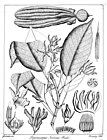Note: This is a project under development. The articles on this wiki are just being initiated and broadly incomplete. You can Help creating new pages.
Dipterocarpus turbinatus - Asvakarna
Asvakarna is a deciduous tree. Usually grows upto 35 - 50 metres tall. The tree is harvested from the wild mainly for the oleo-resin in its trunk. This is used locally and also exported. The tree also yields a timber of low quality, though this is used on a large scale in the manufacture of plywood.
Contents
- 1 Uses
- 2 Parts Used
- 3 Chemical Composition
- 4 Common names
- 5 Properties
- 6 Habit
- 7 Identification
- 8 List of Ayurvedic medicine in which the herb is used
- 9 Where to get the saplings
- 10 Mode of Propagation
- 11 How to plant/cultivate
- 12 Commonly seen growing in areas
- 13 Photo Gallery
- 14 References
- 15 External Links
Uses
Skin disorders, Urinary tract disorders, Ulcers, wounds, fever, Worm infestation, Ear disorders [1]
Parts Used
Chemical Composition
Common names
| Language | Common name |
|---|---|
| Kannada | Challaane, Kalpaini, Googe, Valivara |
| Hindi | Garjan, Teli-garjan, Tihya-garjan |
| Malayalam | |
| Tamil | Challani, Enney, Enneymaram, Karalam, Karccamaram, Vellenney, Yennar |
| Telugu | |
| Marathi | NA |
| Gujarathi | NA |
| Punjabi | NA |
| Kashmiri | NA |
| Sanskrit | Ajakarna, Asvakarna |
| English |
Properties
Reference: Dravya - Substance, Rasa - Taste, Guna - Qualities, Veerya - Potency, Vipaka - Post-digesion effect, Karma - Pharmacological activity, Prabhava - Therepeutics.
Dravya
Rasa
Tikta (Bitter), Katu (Pungent)
Guna
Laghu (Light), Snigdha (Oily)
Veerya
Ushna (Hot)
Vipaka
Katu (Pungent)
Karma
Kapha, Vata
Prabhava
Habit
Identification
Leaf
| Kind | Shape | Feature |
|---|---|---|
| Simple | Alternate | 7-25 x 4-17.5 cm, ovate, apex acute or acuminate, base acute, obtuse or cordate, margin crenate, undulate, glabrous, coriaceous. |
Flower
| Type | Size | Color and composition | Stamen | More information |
|---|---|---|---|---|
| Bisexual | Axillary spiciform racemes | White-pink | 30 | Fragrant, 3-5 together in axillary racemes. |
Fruit
| Type | Size | Mass | Appearance | Seeds | More information |
|---|---|---|---|---|---|
| Nut | 10 x 2 cm | Wings 2, oblong, reddish-brown | {{{6}}} |
Other features
List of Ayurvedic medicine in which the herb is used
Where to get the saplings
Mode of Propagation
How to plant/cultivate
Season to grow
Soil type
Propagation
Commonly seen growing in areas
Photo Gallery
References
External Links
- Ayurvedic Herbs known to be helpful to treat Skin disorders
- Ayurvedic Herbs known to be helpful to treat Urinary tract disorders
- Ayurvedic Herbs known to be helpful to treat Ulcers, wounds
- Ayurvedic Herbs known to be helpful to treat fever
- Ayurvedic Herbs known to be helpful to treat Worm infestation
- Ayurvedic Herbs known to be helpful to treat Ear disorders
- Herbs with Oil used in medicine
- Herbs with Bark used in medicine
- Herbs with Leaves used in medicine
- Herbs with common name in Kannada
- Herbs with common name in Hindi
- Herbs with common name in Tamil
- Herbs with common name in Sanskrit
- Habit - Tree
- Index of Plants which can be propagated by Seeds
- Herbs that are commonly seen in the region of Tropical area
- Herbs
- Plants of western ghats
- Dipterocarpaceae


